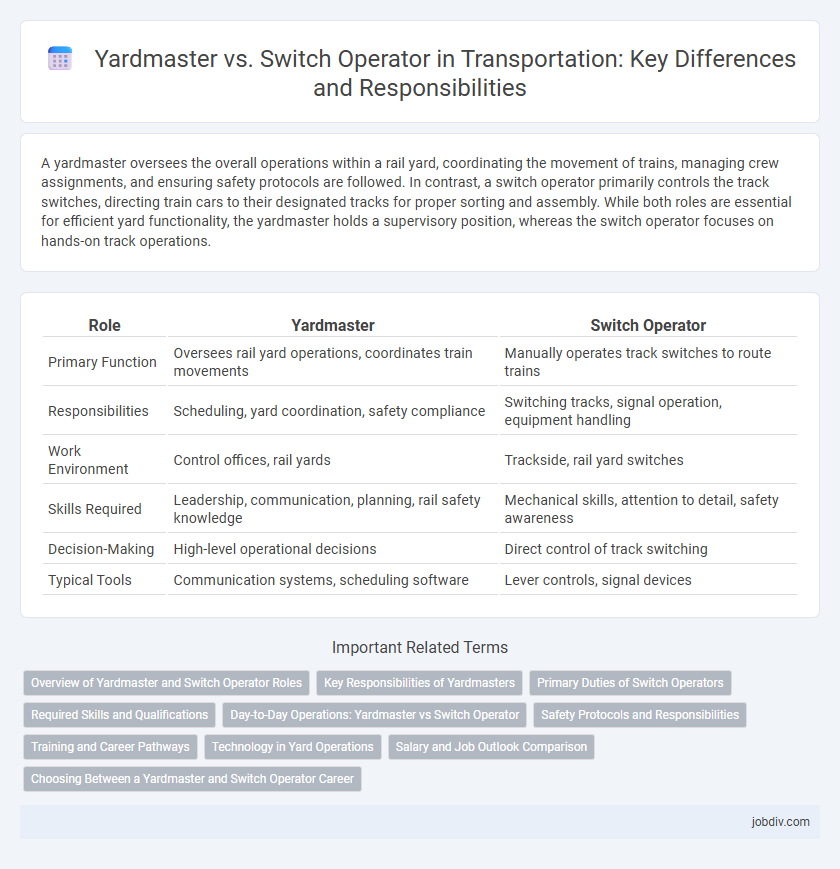A yardmaster oversees the overall operations within a rail yard, coordinating the movement of trains, managing crew assignments, and ensuring safety protocols are followed. In contrast, a switch operator primarily controls the track switches, directing train cars to their designated tracks for proper sorting and assembly. While both roles are essential for efficient yard functionality, the yardmaster holds a supervisory position, whereas the switch operator focuses on hands-on track operations.
Table of Comparison
| Role | Yardmaster | Switch Operator |
|---|---|---|
| Primary Function | Oversees rail yard operations, coordinates train movements | Manually operates track switches to route trains |
| Responsibilities | Scheduling, yard coordination, safety compliance | Switching tracks, signal operation, equipment handling |
| Work Environment | Control offices, rail yards | Trackside, rail yard switches |
| Skills Required | Leadership, communication, planning, rail safety knowledge | Mechanical skills, attention to detail, safety awareness |
| Decision-Making | High-level operational decisions | Direct control of track switching |
| Typical Tools | Communication systems, scheduling software | Lever controls, signal devices |
Overview of Yardmaster and Switch Operator Roles
Yardmasters coordinate daily operations within rail yards, overseeing train movements, crew assignments, and equipment logistics to ensure efficient yard flow. Switch operators control track switches and signals, enabling the safe routing of trains through complex track networks. Both roles are essential for maintaining operational safety and efficiency in rail transportation.
Key Responsibilities of Yardmasters
Yardmasters oversee the coordination and movement of railcars within a rail yard, ensuring efficient train assembly and dispatch. They manage yard personnel, monitor yard operations for safety compliance, and optimize the flow of freight to meet scheduling demands. Their role involves strategic planning to prevent bottlenecks and maintain seamless rail yard productivity.
Primary Duties of Switch Operators
Switch Operators primarily control track switches to route trains safely within rail yards by manually or remotely adjusting track alignments. They monitor train movements to prevent collisions and ensure efficient train assembly and dispatch. Their duties also include communicating with yard crews and dispatchers to coordinate train movements and maintain operational safety.
Required Skills and Qualifications
Yardmasters must possess strong leadership abilities, excellent communication skills, and in-depth knowledge of rail yard operations, often requiring extensive experience in train dispatching and crew coordination. Switch operators need precise mechanical skills, attention to detail, and proficiency in operating track switching equipment, typically supported by technical training in railroad signaling systems. Both roles demand safety awareness and compliance with federal regulations, but Yardmasters generally require supervisory qualifications while Switch Operators focus on technical proficiency.
Day-to-Day Operations: Yardmaster vs Switch Operator
Yardmasters coordinate train movements within the rail yard, overseeing scheduling, routing, and crew assignments to ensure efficient flow and safety. Switch operators control track switches and signals, facilitating precise car movements and preventing collisions during assembly or disassembly of trains. Both roles demand real-time decision-making and communication to optimize yard operations and maintain schedule adherence.
Safety Protocols and Responsibilities
Yardmasters oversee yard operations ensuring safe coordination of train movements, inspection of equipment, and enforcement of strict safety protocols to prevent accidents. Switch Operators are responsible for manually controlling track switches to route trains safely, requiring constant vigilance to adhere to signal regulations and communication standards. Both roles demand adherence to Federal Railroad Administration safety guidelines and effective teamwork to maintain secure yard environments.
Training and Career Pathways
Yardmasters typically require comprehensive training in yard operations, safety protocols, and crew management, often progressing through supervisory roles or rail industry certifications. Switch operators undergo specialized technical training focused on track switching equipment, signaling systems, and operational procedures, with career paths leading to advanced technical roles or yardmaster positions. Both roles emphasize safety and operational efficiency, but yardmasters have broader managerial responsibilities, making their career trajectory more oriented toward leadership within rail yard operations.
Technology in Yard Operations
Yardmasters leverage advanced yard management systems (YMS) and real-time GPS tracking to coordinate railcar movements efficiently, optimizing the flow within rail yards. Switch operators operate manual or semi-automated switch machines but are increasingly supported by remote control technology and integrated communication systems for precise track switching. The integration of IoT sensors and AI-driven analytics enhances decision-making, allowing yardmasters to oversee operations holistically while switch operators execute specific track changes, driving overall yard productivity and safety.
Salary and Job Outlook Comparison
Yardmasters typically earn an average salary ranging from $60,000 to $80,000 annually, reflecting their supervisory role in managing rail yard operations and crews. Switch operators, often earning between $40,000 and $55,000 per year, focus on controlling track switches and ensuring safe train movements. The job outlook for yardmasters shows steady demand through 2030 due to increased freight rail activity, while switch operators face moderate growth driven by infrastructure maintenance and modernization projects.
Choosing Between a Yardmaster and Switch Operator Career
Choosing between a yardmaster and switch operator career depends on preferred responsibilities and work environment. Yardmasters oversee railroad yard operations, coordinating train movements and crew assignments, requiring strong leadership and organizational skills. Switch operators handle track switching and signal control, demanding technical precision and real-time decision-making in dynamic settings.
Yardmaster vs Switch Operator Infographic

 jobdiv.com
jobdiv.com